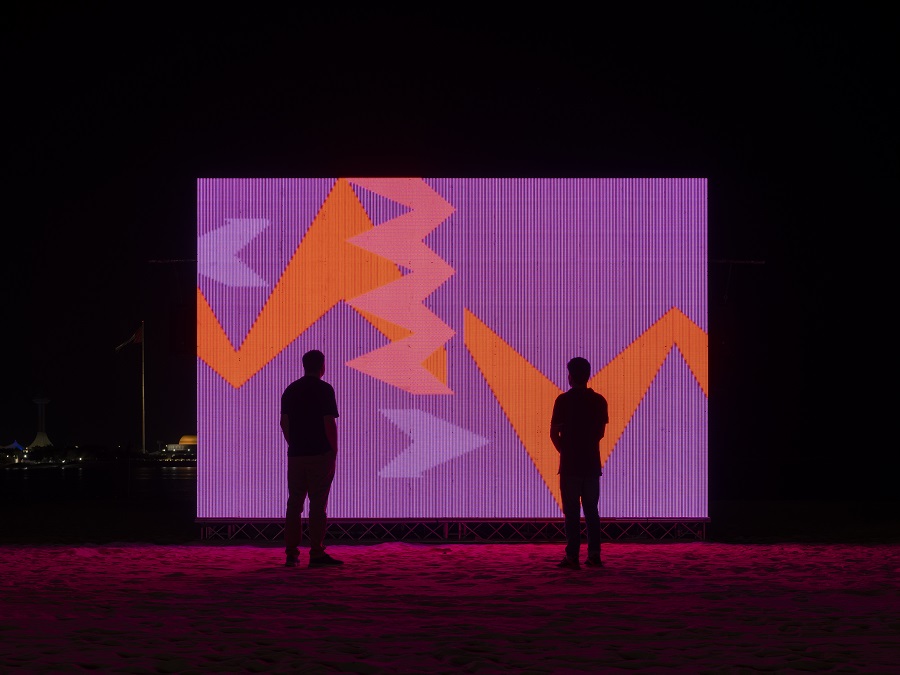ABU DHABI: In an expansive patch of desert just outside Abu Dhabi, dozens of pyramids made from sand seem to recreate multiple iterations of Egypt’s Giza pyramids.
The awe-inspiring land artwork is made by US artist Jim Denevan and titled “Self Similar.” The hand-sculpted pyramids, extending to majestic heights of 27 meters, are positioned in a circular formation spanning an area of nearly a square kilometer. Dubbed the artist’s most ambitious project to date, “Self Similar” has been erected as part of the inaugural Manar Abu Dhabi, a Public Art Abu Dhabi initiative that runs from Nov. 15 to Jan. 30. Manar Abu Dhabi sees the UAE capital’s natural landscapes transformed through 35 new site-specific commissions.

US artist Jim Denevan's 'Self Similar.' (Supplied)
The installation echoes “Angle of Repose” — a piece the artist created in Saudi Arabia’s ancient desert region of AlUla for Desert X in 2022. “Self-Similar” brings the artist’s magic to the UAE, exemplifying a desire in the country for public works of art that inspire both residents and visitors.
Manar, which means “lighthouse” in Arabic, marks a significant cultural milestone for the city, Reem Fadda — co-curator of the exhibition, as well as director of Abu Dhabi Cultural Programming and Cultural Foundation and the artistic director of Public Art Abu Dhabi — told Arab News.
“It embodies Department of Culture and Tourism — Abu Dhabi’s commitment to public art and the transformative power of light,” she said. “Light art has a unique ability to interact with and enhance natural and urban landscapes, making it an ideal medium to showcase in Abu Dhabi’s diverse environments. By integrating art with the city’s archipelagos and mangroves, Manar fosters a new way of seeing and experiencing our surroundings.”

Ahmed Al-Areef's 'Memories of a Harbor.' (Supplied)
The inaugural exhibition is staged under the theme of “Grounding Light,” inspired, explains Fadda, “by the idea of connecting the ethereal aspect of light with the physical world symbolizing the harmonious blend of Abu Dhabi’s natural beauty with the creative expression of light.”
“Light pieces transcend traditional art boundaries, allowing for an inclusive and engaging experience for residents and visitors,” she said. “They serve as bridges connecting our past, present and future, and as tools to inspire imagination and appreciation of our environment.”
The 35 new artworks include pieces by Mohammed Kazem, Rafael Lozano-Hemmer, Samia Halaby, Ala Edris and Carsten Holler, among others.
The international mix of artists brings a variety of interpretations to the medium of light, demonstrating its versatility.
For example, explained co-curator Alia Zaal Lootah, “Mohammed Kazem’s work features a 20-meter-high lighthouse structure on the edge of Al-Samaliyah Island. This piece, visible from the water, is a continuation of Kazem’s ongoing narrative of man at sea, while being reflective of the Manar Abu Dhabi concept.”
Palestinian artist Samia Halaby’s “Kinetic Painting” pieces mark a significant evolution of her work from when they were first exhibited in the 1990s.

Work by Palestinian artist Samia Halaby. (Supplied)
“Halaby began coding in the 1980s, a rare feat at the time. We wanted to show her lesser-known works of that period; that’s how “City” and “Yafa” (both 1992-2019) have been transposed from smaller computer screens of the era to large-scale digital canvases on Corniche Beach, showcasing a fusion of technology and art,” Lootah said.
Elsewhere, positioned on Abu Dhabi’s corniche, is Emirati artist Latifa Saeed’s “Al-Duroob,” which translates into “the passages” in English.

Latifa Saeed's 'Al-Duroob.' (Supplied)
The startling structure is constructed from 5,000 glass bricks, with the undulating wall structure offering a dynamic interplay between “veiling and unveiling, concealing and concealing, constriction and contraction, as well as boundlessness and restriction.”
“The platform supports an open dialogue between UAE-based artists and international artists,” Saeed told Arab News. “We are witnessing a flourishing art scene which reflects the vitality and cultural richness of our nation. It’s a testament to creativity, expression, and the vibrancy of our society.”












